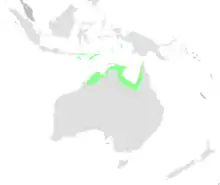Arafura fantail
The Arafura fantail (Rhipidura dryas), sometimes known as the wood fantail, inhabits the Lesser Sunda Islands, the northern coast of Australia from the Kimberley to the western side of the Cape York Peninsula, including subcoastally in the Top End of the Northern Territory, and southern New Guinea. It is similar to the rufous fantail, from which it has been split taxonomically but, apart from minor overlap in the eastern Moluccas, their geographic ranges are discrete. It is generally duller than the rufous fantail with the rufous colouration more restricted.[1][2]
| Arafura fantail | |
|---|---|
.jpg.webp) | |
| Scientific classification | |
| Kingdom: | Animalia |
| Phylum: | Chordata |
| Class: | Aves |
| Order: | Passeriformes |
| Family: | Rhipiduridae |
| Genus: | Rhipidura |
| Species: | R. dryas |
| Binomial name | |
| Rhipidura dryas Gould, 1843 | |
 | |
| Approximate species' distribution | |
Subspecies
According to IOC there are 11 recognised subspecies.[3] In alphabetical order, these are:
- R. d. celebensis Büttikofer, 1892
- R. d. dryas Gould, 1843
- R. d. elegantula Sharpe, 1879
- R. d. hamadryas Sclater, PL, 1883
- R. d. henrici Hartert, E, 1918
- R. d. mimosae Meise, 1929
- R. d. reichenowi Finsch, 1901
- R. d. semicollaris Müller, S, 1843
- R. d. squamata Müller, S, 1843
- R. d. streptophora Ogilvie-Grant, 1911
- R. d. sumbensis Hartert, E, 1896
Related species
| ||||||||||||||||||||||||||||||
| Consensus phylogeny tree of a clade within the fantails (Rhipiduridae) according to Nyári et al. (2009)[4] |
It is one of over 40 member species of the genus Rhipidura, commonly known as the fantails. Within the genus it belongs to a group of five closely related species: R. rufidorsa, R. brachyrhyncha, R. dahli, R. teysmanni and R. rufifrons. A molecular phylogeny study showed the Rufous fantail (Rhipidura rufifrons) to be its closest relative.[4]
It forms a superspecies with R. rufifrons and R. semirubra, and all three are often considered conspecific. All are part of a larger species group that also includes R. teysmanni, R. superflua, R. dedemi, R. opistherythra, R. lepida, R. rufidorsa, R. dahli, R. matthiae and R. malaitae.[5]
References
- Schodde, R.; & Mason, I.J. (1999). The Directory of Australian Birds: Passerines. CSIRO Publishing: Melbourne. ISBN 0-643-06456-7
- Christidis, Les; & Boles, Walter E. (2008). Systematics and taxonomy of Australian birds. CSIRO Publishing: Melbourne. ISBN 978-0-643-06511-6
- Gill F., Donsker D. & Rasmussen P. (Eds.): Orioles, drongos, fantails. IOC World Bird List (v11.2). doi:10.14344/IOC.ML.11.2
- Nyári, Árpád S; Benz, Brett W.; Jønsson, Knud A.; Fjeldså, Jon; Moyle, Robert G. (2009). "Phylogenetic relationships of fantails (Aves: Rhipiduridae)". Zoologica Scripta. 38 (6): 553–561. doi:10.1111/j.1463-6409.2009.00397.x. S2CID 84865515.
- Mayr, Erynst; Moynihan, Martin (1946). "Evolution in the Rhipidura ruffifrons group". American Museum Novitates (1321): 1–21. hdl:2246/4445.
